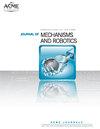索驱动超冗余度机械臂的自适应分段几何逆运动学求解方法
IF 2.2
4区 计算机科学
Q2 ENGINEERING, MECHANICAL
Journal of Mechanisms and Robotics-Transactions of the Asme
Pub Date : 2023-05-23
DOI:10.1115/1.4062606
引用次数: 1
摘要
电缆驱动超冗余度机械手(CDHM)具有多自由度,结构灵活、柔顺,在狭小空间中具有较高的机动性。然而,机械手自由度的增加使得求解其逆运动学非常具有挑战性。本文提出了一种新的自适应分段几何方法来求解CDHM的逆运动学。传统方法,即雅可比矩阵的广义逆和人工神经网络方法,相应的计算效率会低得多。当机械手的末端执行器需要在更大的范围内移动时,需要考虑关节角度的物理极限,并且所提出的方法可以选择最佳的圆弧配置来解决逆运动学问题,以减少关节超驰。为了使关节运动更加合理,避免奇异配置,进一步引入了自适应调整系数来优化配置。然后将所提出的新方法求解的几何参数和关节参数与具有相同期望目标位置的现有方法进行比较,以验证所提出的方法的有效性。最后,构建了一个12自由度超冗余度机械手物理样机,相应的实验结果表明,采用该求解方法,机械手末端可以精确到达预期目标位置,计算复杂度显著降低,有利于在实际应用中提高CDHM的实时控制效率。本文章由计算机程序翻译,如有差异,请以英文原文为准。
Inverse Kinematics Solution Method of an Adaptive Piecewise Geometry for Cable-Driven Hyper-Redundant Manipulator
Cable-driven hyper-redundant manipulator (CDHM) with flexible and compliant configuration has high maneuverability in a tight space owing to its multiple degrees of freedom (DOFs). However, an increase in the DOFs of the manipulator makes it very challenging to solve its inverse kinematics. The present work proposes a novel adaptive piecewise geometry method to solve the inverse kinematics of the CDHM. The corresponding computation efficiency will be much lower for traditional methods, i.e., the generalized inverse of the Jacobian matrix and artificial neural network method. When the end-effector of the manipulator is required to move with a larger range, Joint angle physical limit need to be considered and the proposed method can select the optimal arc configuration to solve the inverse kinematics aiming at reducing joint overrun. An adaptive adjustment coefficient is further introduced to optimize the configuration so that joint motion more reasonable as well as avoid singular configuration. The geometry and joint parameters solved with the proposed novel method are then compared to those of the existing method with the same desired target position to verify the effective of the proposed novel method. Finally, a 12-DOFs hyper-redundant manipulator physical prototype is built, and corresponding experimental results show that with the novel solution method, the manipulator end can precisely reach the expected target position with significantly less computational complexity, which is beneficial to improve real-time control efficiency of the CDHM in practical applications.
求助全文
通过发布文献求助,成功后即可免费获取论文全文。
去求助
来源期刊

Journal of Mechanisms and Robotics-Transactions of the Asme
ENGINEERING, MECHANICAL-ROBOTICS
CiteScore
5.60
自引率
15.40%
发文量
131
审稿时长
4.5 months
期刊介绍:
Fundamental theory, algorithms, design, manufacture, and experimental validation for mechanisms and robots; Theoretical and applied kinematics; Mechanism synthesis and design; Analysis and design of robot manipulators, hands and legs, soft robotics, compliant mechanisms, origami and folded robots, printed robots, and haptic devices; Novel fabrication; Actuation and control techniques for mechanisms and robotics; Bio-inspired approaches to mechanism and robot design; Mechanics and design of micro- and nano-scale devices.
 求助内容:
求助内容: 应助结果提醒方式:
应助结果提醒方式:


